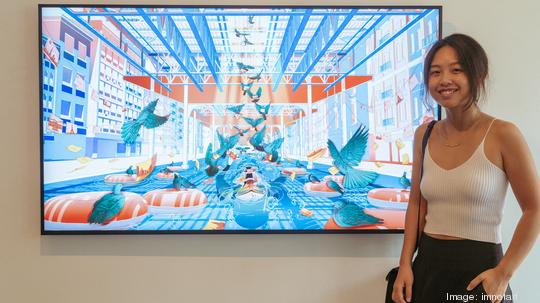With NFTs selling for eye-popping amounts—including a CryptoPunk that sold for more than $4.5 million last week and an Art Block that went for over $2 million—the emerging industry of NFT art has the cryptocurrency world in a frenzy. And in Chicago, a community of artists, collectors and investors is beginning to take shape.
NFTs, or non-fungible tokens, is a technology that's built on a blockchain that certifies a digital asset. It's become increasingly used in the digital art and collectable world, with art pieces routinely selling for thousand, and sometimes millions, of dollars. The art itself can look rather simple, like CryptoPunks, which are pixelated portraits that launched in 2017 as a fixed set of 10,000 individual NFTs. But don't let their unassuming nature fool you. CryptoPunk sale volume has surpassed $1 billion, with single pieces costing hundreds of thousands. Other NFT art pieces can be more complex, with some pieces being featured at famed art auctioneer Christie's. Even corporations like Visa are ponying up for NFTs, which dropped $150,000 for a CryptoPunk just last week.
In Chicago, you'll find early adopters of the burgeoning NFT space at imnotart, Chicago's first physical NFT art gallery. The space, which showcases pieces from digital artists around the world, held its first auction earlier this month in a collection called “The New Digital: Born in Chicago." The exhibit featured 11 pieces from seven artists, selling for a combined total of more than $140,000. The most expensive piece sold for more than $22,000.

For most of the NFT artists, it was their first time selling work in an official exhibit, imnotart founder Matthew Schapiro said, with the majority of artists landing all-time-high prices for their pieces.
"[The artists] loved the ability to have a platform to show off their work and tell their story," Schapiro said. "We really didn’t know what to expect. Being our first time, I was definitely happy with the result. We think it's something we can build on."
Chicago artist Willea Zwey was among those exhibiting their work at the auction. She sold her piece, titled Until We Meet Again, for more than $9,000. It was her personal best purchase price since first creating NFT artwork in February. After transitioning from a career in architecture, Zwey began making digital art in 2020 before learning about NFTs this year.
"The more I learned about the technology and its community, it was a good fit for what I’ve been doing in terms of digital art," she said.
Another local NFT artist, Josie Bellini, sold a piece at Christie's in June for a whopping $400,000. It was a 1 of 1 and the very first piece she ever created, Bellini said, and the highest price she's received for her work to date.
"That was pretty crazy to see," said Bellini, who has seen her work sell on secondary markets for as high as $330,000. Thanks to the smart contracts that NFTs are built upon, artists can get a percentage of sales each time their artwork is sold. In that instance, Bellini sold her piece originally for $5,000 but received a cut when it sold again for $330,000. Bellini said she typically sets her royalties between 5-10%.
As the value of NFTs skyrockets, the question becomes are buyers looking for piece of art, or a lottery ticket? For Bellini, she believes collectors still need to have a connection with a piece, even if they believe its value will grow.
"If you’re buying art, it's because you connect with it for some reason," she said. "You actually have to love it and there has to be a reason that you see that it's worth purchasing."
Andrew Steinwold, a Chicago crypto analyst, is the founder of Sfermion, an investment company focused on NFTs. The fund, which launched in January, says it's the world’s first investment firm focused on non-fungible tokens and has purchased more than 1,000 NFTs.
Steinwold, who appeared on Fortune's list of the 50 most influential people in NFTs, began investing in the crypto space in 2013 and was first introduced to NFTs in 2019. He said the rise in NFT popularity caught many in the community off guard.
"I think most people in the ecosystem were pretty shocked at how quickly and how rapidly everyone jumped into the NFT space," he said. "Short periods of craziness are normal with every new technology people discover ... (But) the real builders in this space are long-term believers that are building great products."
Ezra Galston, a Chicago tech investor and founder of venture capital firm Starting Line, said the rise of NFTs can be explained by our increasingly digital lives. NFTs, which have been used in profiles pictures on Twitter and other social platforms, are becoming part of our digital identity and a way to create "community via ownership," Galston said.
"It's so logical and rational that in the same way that we use clothing as a way of creating our own identities in the physical world, there would be assets that represent our identities in the digital world," he said. "The convergence of community alongside digital identify is super powerful."
Galston's firm Starting Line doesn't invest in any NFTs directly, but isn't ruling it out. It has, however, invested in NFT platform Hic Et Nunc's “governance token,” along with Stacked Invest, which operates an NFT index. Galston also personally invests in NFTs, including CryptoPunks and Art Blocks.
He acknowledged that it's too soon to tell how much of the NFT growth is spurred by people who love collecting and believe in it for the long term, versus those who are looking to flip a digital art piece for a quick buck. But for those who truly buy in to the potential of NFTs, many think we're in the early innings of revolutionary, game-changing tech.
"It could be that interest in NFTs wane and ultimately the art [collectors are] holding is not worth very much," he said. "But on the flip side, I think they truly do believe that there’s a high percentage chance that 20 years from now, 30 years from now, our kids can’t believe that we actually own a CryptoPunk."
NFT education is a critical piece of imnotart's mission, Schapiro said, who advised that someone just learning about cryptocurrency probably shouldn't put their money into NFTs right away.
"You don’t want to buy Ethereum and immediately put it into a piece of art," he said. "Yes, these things can be viewed as an investment, but when you're purchasing an NFT, you want to purchase something that you like, that means something to you. And that you’re not just counting its value as part of your portfolio."
"Our point of view is NFTs should be looked at as pieces of fine art, rather than a way of investing in the crypto market," he added.



